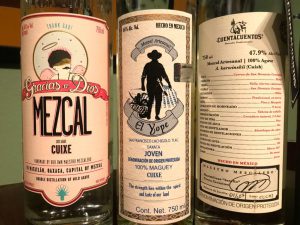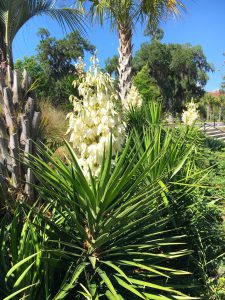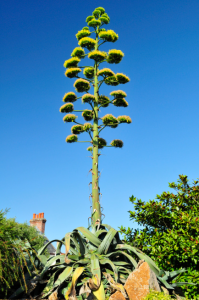 Bring mezcal to life; grow agaves in the garden!
Bring mezcal to life; grow agaves in the garden!
Agave is generally tolerant of Florida’s climate with its succulent leaves showcasing different shades of greens and blues. The shape of the plant generates interest, and it makes a great statement in the landscape. A plant can and should resemble so much more. Plants and gardens weave the stories of human experience.
Mezcal represents a fantastic group of spirits distilled from roasted and crushed agaves from specific regions of Mexico. While not as ancient as wine, mezcal has likely been distilled and consumed since the Spanish brought techniques to the New World in the 1500s. Prior to that, the indigenous preferred hallucinogenic excursions, truly spiritual, using mescaline containing cacti among other powerful local herbs (read One River by Wade Davis to learn more). The similarity of terminology, mezcal and mescaline, is likely to blame for people incorrectly assuming “mezcal” has hallucinogenic effects–it does not–it just takes you from sippy, to tipsy, to drunk like many other alcoholic distillates predictably do.
Mezcal, more like wine or champagne
More like wine, different types of mezcal come from different species of agave struggling in different climates developing unique complex flavors! Furthermore, those different species of agave grow in different regions and soil types; some are more rare, others take decades to mature. Then, there is the maturation process, or aging. “Joven” is young, “reposado” is rested, and “anejo” is aged. Tequila, technically a type of mezcal only from the blue agave, follows similar aging terminology, but not all mezcal is tequila.

Much like “champagne” describing a specific product confined to a certain region, mezcal is defined as a “Mexican distilled alcoholic beverage, 100% from maguey or agave, obtained by distillation of fermented juices with spontaneous or cultivated microorganisms, extracted from mature heads of maguey or cooked agaves, harvested in the territory covered by the DOM (Denomination Origin of Mezcal).” If you do not follow the rules or pay for the cost of mezcal certification, you get to call your liquor “distilled agave beverage.” While it is difficult to know exactly how much the mezcal market has increased due to the labelling and certification requirements, it is clear the market has surged!
Ethnobotany is the study of the way people use plants. To me, it is by far the most fascinating subject that combines culture, botany, ecology, and agriculture into the human experience. Ethnobotany is also ever-evolving. Think, 500 years ago, the ethnobotany of the Oaxacan people would be based on cocoas, cactus, and corn, not alcohol. But today, it is hard to imagine Mexican tradition without tequila and tacos.
Can we grow gardens that celebrate culture here in Florida? Why not?
While roasting, mashing, and distilling the agave juices may not be a backyard reality or legality, you can grow plants that are both beautiful and culturally significant. You can tell stories of plants, people, and culture. You can support artisans from far away by purchasing their craft products and pouring them out for friends. You can learn about entomology, chemistry, and biology potentially inspiring the next generation of scientists, entrepreneurs, and explorers who have a heightened awareness and appreciation of ethnobotany.
While mezcal production is limited to specific regions of Mexico, could “distilled agave beverages” be a market for Florida growers and distillers? I would easily argue that cane and agave distillates are the most Florida forms of alcohol that could be completely produced within the state using all local products. Sorry, local beer, I love you, but for now, your most Florida ingredient is water, and while hops are so cool and can grow here, they are not perfectly adapted like our amigo agave.
Gardens can tell stories about the human experience. The agave is a fantastic landscape plant that is low maintenance, low water use, salt tolerant, and looks wicked cool. Florida growers already grow it and it graces many landscapes.

Florida Native Plants of the Agave Family
Florida boasts multiple species of natives within the agave plant family, though I am not sure any have been used for making booze. These are still impressive species perfectly adapted to this great state that bring added advantages when included in the garden. Natives support more local wildlife that has adapted and evolved along with these native species. Whether you see it or not, adding natives stacks ecosystem services. It is like a Roth IRA investment into the future of Florida. As Martha Stewart would say, “It is a good thing.”
Agave decipiens
Agave virginica
Yucca aolifolia
Yucca filamentosa
Yucca gloriosa
Mezcal Agave Types
Personally, I love a garden that tells a story. It will often thrive long beyond each of its caretakers. If you want to include some agaves used for making mezcal in your garden, here are the main species used. Winemag.com has a great article that highlights the different characteristcs of each agave and their spirits.

Scientific name: Agave angustifolia
Other common names: Espadín, Espadilla, Tepemete, Pelón Verde
Scientific name: Agave rhodacantha
Other common names: Mexicano, Espadillón, Ixtero Amarillo, Cuixe
Scientific name: Agave americana
Other common names: Arroqueño, Sierra Negra, Serrano, Sierrudo, Coyote
Scientific name: Agave karwinskii
Other common names: Karwinskii, Madrecuixe, Bicuixe, Cuixe, Tobaziche, Barril, Cirial
Scientific name: Agave marmorata
Other common names: Tepeztate, Pichomel, Pichometl
Scientific name: Agave potatorum
Other common names: Tobalá, Papalomé, Papalométl
Scientific name: Agave cupreata
Other common names: Cupreata, Papalote, Gordito, Ancho
Scientific name: Agave durangensis
Common name: Cenizo
Want to find some agaves for your landscape?
The following two resources are great for finding the next great garden addition, or for you plant nerds out there, the absolute MUST HAVE.
 3
3
